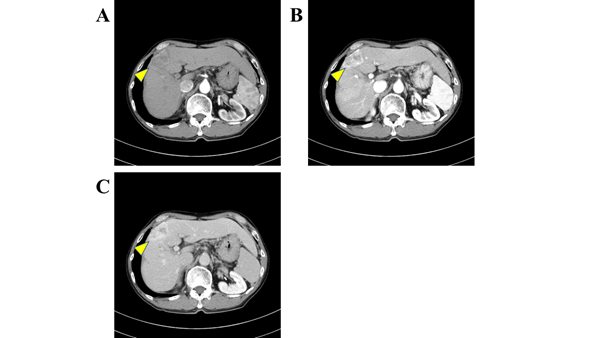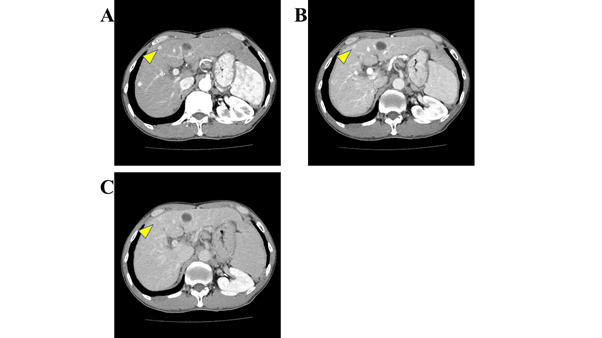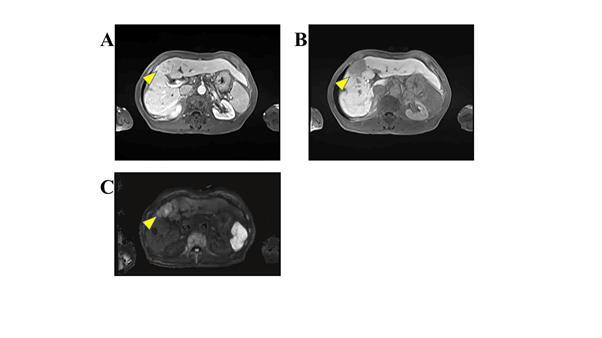Image Article - (2022) Volume 6, Issue 3
Received: 05-Apr-2022, Manuscript No. iprjo-22-12827; Editor assigned: 07-Apr-2022, Pre QC No. iprjo-22-12827 (PQ); Reviewed: 21-Apr-2022, QC No. iprjo-22-12827; Revised: 26-Apr-2022, Manuscript No. iprjo-22-12827 (PQ); Published: 03-May-2022, DOI: 10.36648/iprjo.6.3.11
Programmed In a patient with a history of hepatitis B virus related hepatocellular carcinoma, a tumor initially diagnosed as hepatic hemangioma gradually increased in size over a 7 year period. Considering malignancy, surgery was performed. Histopathologically the tumor was diagnosed as combined hepatocellular-cholangiocarcinoma.
Combined hepatocellular-cholangiocarcinoma; Hepatic hemangioma
The patient was a 71 year old man visited our hospital due to hepatitis B virus infection. Seven years ago, a tumor was found in segment (S) 8 of the liver, diagnosed as hepatocellular carcinoma. He received radiofrequency ablation. At the same time, computed tomography (CT) showed another tumor that was 20 mm in S4. A hepatic hemangioma was considered by dynamic CT (Figure 1).

Figure 1: (A) Dynamic CT images show a faint lesion in the early phase (yellow arrowhead). (B) Mosaic pattern containing both enhancing and non-enhancing areas in the portal phase (yellow arrowhead). (C) Faded and delayed contrast-enhancing areas in the late phase (yellow arrowhead). CT, computed tomography.
After 7 years, the tumor was measured at 35 mm. The tumor was well enhanced after the portal phase and showed a low signal intensity in the hepatobiliary phase of gadolinium ethoxybenzyl diethlenetriamine pentaacetic acid-enhanced magnetic resonance imaging (Figure 2). On dynamic CT, the tumor was only slightly enhanced in the early phase; however, the tumor gradually enhanced and enhanced contrast in the late phase (Figure 3). As the possibility of malignancy, partial liver resection was performed. Histopathologically, the tumor was diagnosed as combined hepatocellular-cholangiocarcinoma (cHCC-CCA) [1].

Figure 2: Gd-EOB-DTPA-enhanced MRI showing a well-enhanced lesion after the portal phase (yellow arrowhead) (A) and a low signal intensity lesion in the hepatobiliary phase (yellow arrowhead) (B). On DWI, the signal was not high (yellow arrowhead) (C). MRI, magnetic resonance imaging; Gd-EOB-DTPA, gadolinium ethoxybenzyl diethlenetriamine pentaacetic acid; DWI, diffusion-weighted imaging.

Figure 3: (A) Dynamic CT showing a slightly enhanced lesion in the early phase (yellow arrowhead). (B) The tumor was well enhanced in the portal phase (yellow arrowhead). (C) The tumor contrast continued in the late phase (yellow arrowhead).
The prognosis of cHCC-CCA is poor; hence, this case is notable as the tumor was resected after a prolonged period [2]. Regardless, clinicians should consider the possibility of cHCC-CCA in patients who have underlying liver disease or advanced fibrosis with atypical imaging findings despite an initial impression of a hepatic hemangioma.
The authors declare that there are no conflicts of interests
The authors received no financial support for the preparation of this article.
Institutional review board approval was exempted at our institution for this retrospectively designed report and informed consent was obtained from the patient to publish this report.
AN: wrote the draft of the manuscript and prepared the figures. AN and MK: involved in writing. AN, WK and MK: revised and approved the final manuscript.
No relevant acknowledgments.
Written informed consent was obtained from the patient to publish this report in accordance with the journal’s patient consent policy.
The data that support the findings are available on request from the corresponding author.
Citation: Akira N, Koike W, Kajikawa M (2022) Combined Hepatocellular-Cholangiocarcinoma in a Case of Suspected Hepatic Hemangioma. Res J Onco. 6:11.
Copyright: © Akira N, et al. This is an open-access article distributed under the terms of the Creative Commons Attribution License, which permits unrestricted use, distribution, and reproduction in any medium, provided the original author and source are credited.